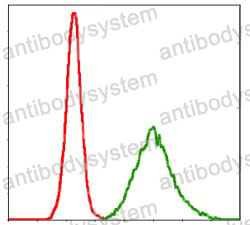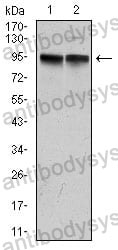Catalog No.
RHE86603
Species reactivity
Human
Host species
Mouse
Isotype
IgG2b
Clonality
Monoclonal
Tested applications
ELISA: 1:10000, FCM: 1:200-1:400, WB: 1:500-1:2000
Target
Voltage-gated potassium channel subunit Kv7.1, Potassium voltage-gated channel subfamily KQT member 1, IKs producing slow voltage-gated potassium channel subunit alpha KvLQT1, KCNQ1, KCNA8, KVLQT1, KQT-like 1, KCNA9
Concentration
1 mg/ml
Endotoxin level
Please contact with the lab for this information.
Purity
>95% as determined by SDS-PAGE.
Purification
Protein A/G purified from cell culture supernatant.
Accession
P51787
Applications
ELISA, FCM, WB
Form
Liquid
Storage buffer
0.01M PBS, pH 7.4, 0.05% Sodium Azide.
Stability and Storage
Use a manual defrost freezer and avoid repeated freeze-thaw cycles. Store at 4°C short term (1-2 weeks). Store at -20°C 12 months. Store at -80°C long term.
Clone ID
R3M70
Lmx1a is essential for marginal cell differentiation and stria vascularis formation., PMID:40109362
A PAS-targeting hERG1 activator reduces arrhythmic events in Jervell and Lange-Nielsen syndrome patient-derived hiPSC-CMs., PMID:39786967
Computational analysis of long QT syndrome type 2 and the therapeutic effects of KCNQ1 antibodies., PMID:39484649
Proof of concept for monoclonal antibody therapy in a cellular model of acquired long QT syndrome type 3., PMID:37947435
Genome-wide association study of placental weight identifies distinct and shared genetic influences between placental and fetal growth., PMID:37798380
Cardiac ion channels associated with unexplained stillbirth - an immunohistochemical study., PMID:35731905
Involvement of muscle satellite cell dysfunction in neuromuscular disorders: Expanding the portfolio of satellite cell-opathies., PMID:35302338
Delayed KCNQ1/KCNE1 assembly on the cell surface helps IKs fulfil its function as a repolarization reserve in the heart., PMID:33963564
A Novel Peptide/Antibody-Based Antiarrhythmic Approach to Long QT Syndrome and Beyond., PMID:32354383
KCNQ1 Antibodies for Immunotherapy of Long QT Syndrome Type 2., PMID:32354382
The unconventional biogenesis of Kv7.1-KCNE1 complexes., PMID:32270035
Characterization and functional roles of KCNQ-encoded voltage-gated potassium (Kv7) channels in human corpus cavernosum smooth muscle., PMID:31919767
Dataset of KCNQ1, KCNN4, KATP channel expression and dexamethasone modulation of protein kinase signaling in airway epithelial cells., PMID:31720320
Sculpting ion channel functional expression with engineered ubiquitin ligases., PMID:29256394
Clinical-pathologic correlations in voltage-gated Kv1 potassium channel complex-subtyped autoimmune painful polyneuropathy., PMID:27511450
Expression and function of Kv7.4 channels in rat cardiac mitochondria: possible targets for cardioprotection., PMID:26718475
Arrhythmogenic cardiomyopathy in a patient with a rare loss-of-function KCNQ1 mutation., PMID:25616976
Chromanol 293B, an inhibitor of KCNQ1 channels, enhances glucose-stimulated insulin secretion and increases glucagon-like peptide-1 level in mice., PMID:25437377
Induced KCNQ1 autoimmunity accelerates cardiac repolarization in rabbits: potential significance in arrhythmogenesis and antiarrhythmic therapy., PMID:25087487
Type 2 diabetes susceptibility gene variants predispose to adult-onset autoimmune diabetes., PMID:24906951
KCNQ1, KCNE2, and Na+-coupled solute transporters form reciprocally regulating complexes that affect neuronal excitability., PMID:24595108
Contribution of kv7.4/kv7.5 heteromers to intrinsic and calcitonin gene-related peptide-induced cerebral reactivity., PMID:24558103
Upregulation of KCNQ1/KCNE1 K+ channels by Klotho., PMID:24457979
Phosphorylation of rat aquaporin-4 at Ser(111) is not required for channel gating., PMID:23616425
KCNQ1 autoantibodies: another way to regulate IKs., PMID:23615563
Anti-KCNQ1 K⁺ channel autoantibodies increase IKs current and are associated with QT interval shortening in dilated cardiomyopathy., PMID:23447643
Disease characterization using LQTS-specific induced pluripotent stem cells., PMID:22739119
N-terminal arginines modulate plasma-membrane localization of Kv7.1/KCNE1 channel complexes., PMID:22073228
AMP-activated protein kinase downregulates Kv7.1 cell surface expression., PMID:21957902
Genome-wide identification of possible methylation markers chemosensitive to targeted regimens in colorectal cancers., PMID:21850381
Inhibition of the heterotetrameric K+ channel KCNQ1/KCNE1 by the AMP-activated protein kinase., PMID:21231794
Targeted deletion of Kcne2 causes gastritis cystica profunda and gastric neoplasia., PMID:20625512
Participation of KCNQ (Kv7) potassium channels in myogenic control of cerebral arterial diameter., PMID:20624791
Differential expression of KCNQ1 K+ channel in tubular cells of frog kidney., PMID:20353914
Histological substrate of human atrial fibrillation., PMID:20006465
Pioglitazone induced gastric acid secretion., PMID:19710534
APC sensitive gastric acid secretion., PMID:19255508
MinK-dependent internalization of the IKs potassium channel., PMID:19202166
Expression of the voltage-gated potassium channel KCNQ1 in mammalian taste bud cells and the effect of its null-mutation on taste preferences., PMID:19006182
Expression and localization of K channels KCNQ2 and KCNQ3 in the mammalian cochlea., PMID:18827480
IKs response to protein kinase A-dependent KCNQ1 phosphorylation requires direct interaction with microtubules., PMID:18390900
KCNE4 can co-associate with the I(Ks) (KCNQ1-KCNE1) channel complex., PMID:18279388
Involvement of KATP and KvLQT1 K+ channels in EGF-stimulated alveolar epithelial cell repair processes., PMID:17631610
Differential diagnosis between complete and partial mole using a TSSC3 antibody: correlation with DNA polymorphic marker analysis., PMID:17165430
Gastric type H+,K+-ATPase in the cochlear lateral wall is critically involved in formation of the endocochlear potential., PMID:16822945
Differential diagnosis between complete and partial mole by TSSC3 antibody completely correlates to DNA diagnosis., PMID:16106198
K+ channel KVLQT1 located in the basolateral membrane of distal colonic epithelium is not essential for activating Cl- secretion., PMID:15843438
KCNE1 binds to the KCNQ1 pore to regulate potassium channel activity., PMID:15207237
Subcellular localization of the delayed rectifier K(+) channels KCNQ1 and ERG1 in the rat heart., PMID:14670813
Charybdotoxin binding in the I(Ks) pore demonstrates two MinK subunits in each channel complex., PMID:14527430


